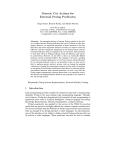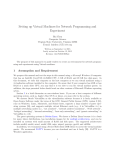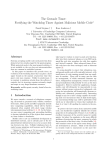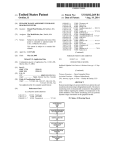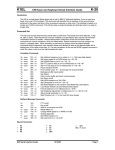Download PDF file
Transcript
Pruning Extensional Predicates in
Deductive Databases
Tiago Soares
Ricardo Rocha
Michel Ferreira
DCC-FC & LIACC, University of Porto
Rua do Campo Alegre, 823, 4150-180 Porto, Portugal
{tiagosoares,ricroc,michel}@ncc.up.pt
Abstract
By coupling Logic Programming with Relational Databases, we can combine the higher expressive power of logic with the efficiency and safety of databases in dealing with large amounts
of data. An important drawback of such coupled systems is the fact that, usually, the communication architecture between both systems is not tight enough to support a completely transparent
use of extensionally (or relationally) defined predicates in the logic program. Such an example is
the cut operation. This operation is used quite often in Prolog programs, both for efficiency and
semantic preservation. However, its use to prune choice-points related to database predicates
is discouraged in existing coupled systems. Typically, SQL queries result sets are kept outside
WAM data structures and the cut implementation leaves the database result set pointer (cursor)
open and the result set data structure allocated in memory, instead of closing the cursor and
deallocating memory. In this work we focus on the transparent use of the cut operation over
database predicates, describing the implementation details in the context of the coupling between the YapTab system and the MySQL RDBMS. Our approach can be generalised to handle
not only database predicates but also any predicate that requires generic actions upon cuts.
1
Introduction
The similarities between logic based languages, such as Prolog, and relational databases have long
been noted. There is a natural correspondence between relational algebra expressions and Prolog
predicates, and between relational tuples and Prolog facts [7]. The main motivation behind a
deductive database system, based on the marriage of a logic programming language and a relational
database management system (RDBMS), is the combination of the inference capabilities of the
logic language with the ultra-efficient data handling of the RDBMS. The implementation of such
deductive database systems follows the following four general methods [1, 14, 6]: (i) coupling of an
existing logic system implementation to an existing RDBMS; (ii) extending an existing logic system
with some facilities of a RDBMS; (iii) extending an existing RDBMS with some features of a logic
language; and (iv) tightly integrating logic programming techniques with those of RDBMS’s.
An example of a tightly integrated implementation is the Aditi system [15], and examples of
coupled implementations are the Coral [8] and XSB [10] systems. Regarding coupled systems, the
literature usually distinguishes between tightly and loosely coupled systems. This classification is
far from being clear, though. Sometimes the tight or loose adjectives are used regarding the degree
of integration from the programming perspective, while sometimes the terms are used regarding
the transparency of the use of logic predicates defined by database relations.
1
The use of explicit SQL queries in logic predicates would characterize a loosely coupled system,
while the specification of database queries transparently in logic syntax would characterize a tightly
coupled system. The usual meaning of the tight and loose terms in the computer industry is,
however, different. Systems are tightly coupled if they cannot function separately and loosely
coupled if they can. Under this definition, the XSB system coupled with a RDBMS results in a
loosely coupled system.
The coupling approach, by keeping the deductive engine separated from the RDBMS, offers
a number of advantages: deductive capabilities can be used with arbitrary RDBMS’s and the
deductive system can profit from future and independent developments of the RDBMS; furthermore,
there are also no extra overheads for programs that do not access data stored in a relational
database. The coupling approach also presents, however, some important drawbacks as compared
with integrated systems. The most relevant is the communication overhead to get external data
from the database server to be unified with logic goals. This overhead is extremely significant and
makes impracticable the use of relation-level access (where SQL queries are generated for each logic
goal) with all but toy applications. View-level access (where relational join operations of logic goals
are executed by the RDBMS) very importantly reduces this communication overhead, particularly
if it allows the efficient use of the RDBMS indices [4].
Another important drawback of loosely or tightly coupled systems is the fact that the communication architecture between both systems is normally based on an interface layer which lacks
important features necessary to improve both the efficiency and the transparent integration of the
logic system and the database system. For instance, the application programming interfaces of
RDBMS’s do not provide adequate mechanisms to send sets of tuples back and forth from the logic
system to the database server, and this has been shown to be crucial to attain good performance [5].
In addition to efficiency concerns, the existing communication architectures between coupled
systems are also not tight enough to support a completely transparent use of relationally defined
predicates in the logic program. Consider, for example, the cut operation. This operation is extremely used in Prolog programs, both for efficiency and semantic preservation. However, its use
after a database defined predicate can have undesired effects, with the current interface architectures of coupled systems. The undesired effects can be so significant that systems such as XSB
clearly state on the programmers’ manual that cut operations should be used very carefully with
relationally defined predicates [11]:
“The XSB-ODBC interface is limited to using 100 open cursors. When XSB systems use
database accesses in a complicated manner, management of open cursors can be a problem
due to the tuple-at-a-time access of databases from Prolog, and due to leakage of cursors
through cuts and throws. Often, it is more efficient to call the database through set-at-a-time
predicates such as findall/3, and then to backtrack through the returned information.”
In this work we focus on the transparent use of the cut operation over database predicates,
describing the implementation details in the context of the coupling between the YapTab system [9]
and the MySQL RDBMS [16]. YapTab is a tabling system that extends Yap’s engine [12] to support
tabled evaluation for definite programs. The remainder of the paper is organized as follows. First,
we briefly describe the cut semantics of Prolog and the problem arising from its use to prune
database predicates. Next, we present how Yap interfaces MySQL through their C API’s. Then,
we describe the needed extension to the interface architecture in order to deal with pruning for
database predicates. At the end, we outline some conclusions.
2
2
Pruning Database Predicates
Ideally, it should be possible to use predicate facts defined extensionally in database relations
exactly as predicate facts defined in a Prolog program. In particular, for the cut operation, it
should be possible to prune predicates independently of how they are defined. In this section we
show why this is a problem for current coupled systems.
2.1
Cut Semantics
Cut is a system built-in predicate that is represented by the symbol ’!’. Its execution results in
pruning all the branches to the right of the cut scope branch. The cut scope branch starts at the
current node and finishes at the node corresponding to the predicate containing the cut.
Figure 1 gives a general overview of cut semantics by illustrating the left to right execution of an
example with cuts. The query goal a(X) leads the computation to the first alternative of predicate
a/1, where !(a) means a cut with scope node a. Predicate b(X) is then called and suppose that
it succeeds in its first alternative binding X with b1. Next, !(a) gets executed and all the right
branches until node a are pruned. As a consequence, the nodes for a and b can be removed.
a(X) :- b(X), !, c(X).
a(X) :- ...
a(X) :- ...
b(X) :- ...
b(X) :- ...
c(X) :- ...
?- a(X).
root
a(X).
root
root
a
a
b(X),!(a),c(X).
root
c(b1).
b
!(a),c(b1).
Figure 1: Cut semantics
2.2
Pruning a Query Result Set
In the coupling interface between a logic system and a database system, logic goals are usually
translated into SQL queries, which are then sent to the database system. To improve performance,
a number of logic goals can be combined on a single SQL query, replacing a relation-level access
for what is known as view-level access. The database system then receives the query, processes it,
and sends the resulting tuples back to the logic system.
MySQL offers two alternatives for sending these resulting tuples to the client program that
generated the query: (i) store the set of tuples on a data structure on the database server side
and send each tuple tuple-at-a-time to the client program; or (ii) store the set of tuples on a data
structure on the client side sending the all set of tuples at once. Logic systems also have two
alternatives to deal with these sets of tuples: (i) use them tuple-at-a-time, exactly as is done for
3
normal facts; or (ii) use them set-at-a-time, typically in a Prolog list structure [3]. Building this
list for thousands or millions of tuples can lead to memory allocation problems and is very time
consuming. Furthermore, the transparent use of facts defined in database relations is lost if they
imply a set-at-a-time use.
For tuple-at-a-time, the obvious method of accessing the tuples in the result set of a query is
to use the backtracking mechanism, which iteratively increments the database result set pointer
(cursor) and fetches the current tuple. Using this tuple-at-a-time access, the deallocation of the
data structure holding the result set, whether on the server or on the client side, is performed when
the last tuple on the result set has been reached.
The problem is when, during the tuple-at-a-time navigation, a cut operation occurs before
reaching the last tuple. If this happens, the result set cannot be deallocated. This can cause a lack
of cursors and, more important, a lack of memory due to a number of very large non-deallocated
data structures. Consider the example described in Fig. 1 and assume now that predicate b/1
is a database predicate. The computation of b(X) will query the database for the correspondent
relation and bind X with the first tuple that matches the query. Next, we execute !(a) and, as
mentioned before, it will disable the action of backtracking for node b. The result set with the facts
for b will remain in memory, although it will never be used.
To solve this problem, we propose an extension to the interface architecture that allows to
associate cut procedures with database predicates, in such a way that the system transparently
executes them when a cut operation occurs. With this functionality, we can thus use these procedures to deallocate the result set for the pruned database predicates and therefore avoid the
problems discussed above. In what follows we briefly describe the Yap interface and then we detail
our approach to extend the interface in order to deal with pruning for database predicates.
3
The C Language Interface to Yap Prolog
Like other Prolog Systems, Yap provides an interface for writing predicates in other programming
languages, such as C, as external modules. An important feature of this interface is how we can
define predicates. Yap distinguishes two kinds of predicates: deterministic predicates, which either
fail or succeed but are not backtrackable, and backtrackable predicates, which can succeed more
than once.
Deterministic predicates are implemented as C functions with no arguments which should return zero if the predicate fails and a non-zero value otherwise. They are declared with a call to
YAP UserCPredicate(), where the first argument is the name of the predicate, the second the
name of the C function implementing the predicate, and the third is the arity of the predicate.
For backtrackable predicates we need two C functions: one to be executed when the predicate
is first called, and other to be executed on backtracking to provide (possibly) other solutions.
They are similarly declared, but using instead YAP UserBackCPredicate(). When returning the
last solution, we should use YAP cut fail() to denote failure, and YAP cut succeed() to denote
success. The reason for using YAP cut fail() and YAP cut succeed() instead of just returning
a zero or non-zero value, is that otherwise, when backtracking, our function would be indefinitely
called. For a more exhaustive description on how to interface C with Yap please refer to [13].
3.1
Writing Backtrackable Predicates in C
To explain how the C interface works for backtrackable predicates we will use a small example
from the interface between Yap and MySQL. We present the db row(+ResultSet,?ListOfArgs)
4
predicate, which fetches tuples from a query result set, tuple-at-a-time through backtracking, and
unifies the list in ListOfArgs with the current tuple. To do so, first a yap mysql.c module should
be created. Next the module should be compiled to a shared object and then loaded under Yap
by executing load foreign files([yap mysql],[],init predicates). After that, the db row/2
predicate becomes available. The code for this module is shown next in Fig. 2.
#include "Yap/YapInterface.h"
// header file for the Yap interface to C
void init_predicates() {
YAP_UserBackCPredicate("db_row", c_db_row, c_db_row, 2, 0);
}
int c_db_row(void) {
int i, arity;
YAP_Term arg_result_set, arg_list_args, head;
MYSQL_ROW row;
MYSQL_RES *result_set;
// db_row: ResultSet -> ListOfArgs
arg_result_set = YAP_ARG1;
arg_list_args = YAP_ARG2;
result_set = (MYSQL_RES *) YAP_IntOfTerm(arg_result_set);
arity = mysql_num_fields(result_set);
if ((row = mysql_fetch_row(result_set)) != NULL) {
for (i = 0; i < arity; i++) {
head = YAP_HeadOfTerm(arg_list_args);
arg_list_args = YAP_TailOfTerm(arg_list_args);
if (!YAP_Unify(head, YAP_MkAtomTerm(YAP_LookupAtom(row[i]))))
return FALSE;
}
return TRUE;
} else {
mysql_free_result(result_set);
YAP_cut_fail();
return FALSE;
}
// get next tuple
// no more tuples
}
Figure 2: The C code for the db row/2 predicate
Figure 2 shows some of the key aspects about the Yap interface. The include statement makes
available the macros for interfacing with Yap. The init predicates() procedure tells Yap, by calling YAP UserBackCPredicate(), the predicate defined in the module. The function c db row()
is the implementation in C of the desired predicate. We can define a function for the first time
the predicate is called and another for calls via backtracking. In this example the same function
is used for both calls. Note that this function has no arguments even though the predicate being
defined has two. In fact the arguments of a Prolog predicate written in C are accessed through the
macros YAP ARG1, ..., YAP ARG16 or with YAP A(N) where N is the argument number.
The c db row() function starts by converting the first argument (YAP ARG1) to the correspondent pointer to the query result set (MYSQL RES *). The conversion is done by the YAP IntOfTerm()
macro. It then fetches a tuple from this result set, through mysql fetch row(), and checks if the
last tuple as been already reached. If not, it calls YAP Unify() to attempt the unification of values
in each attribute of the tuple (row[i]) with the respective elements in arg list args. If unification
fails it returns FALSE, otherwise returns TRUE. On the other hand, if the last tuple has been already
reached, it deallocates the result set, as mentioned before, calls YAP cut fail() and returns FALSE.
5
For simplicity of presentation, we omitted type checking procedures over MySQL attributes
that must be done to convert each attribute to the appropriate term in Yap. For some predicates it
is also useful to preserve some data structures across different backtracking calls. This can be done
by calling YAP PRESERVE DATA() to associate such space and by calling YAP PRESERVED DATA() to
get access to it later. With these two macros we can easily share information between backtracking.
This example does not need this preservation, as the cursor is maintained in the result set structure.
3.2
The Yap Implementation of Backtrackable Predicates
In Yap, a backtrackable predicate is compiled using two WAM-like instructions, try userc and
retry userc, as follows:
try_userc c_first arity extra_space
retry_userc c_back arity extra_space
Both instruction have three arguments: the c first and c back arguments are pointers to the
C functions associated with the backtrackable predicate, arity is the arity of the predicate, and
extra space is the memory space used by the YAP PRESERVE DATA() and YAP PRESERVED DATA()
macros.
When Yap executes a try userc instruction it uses the choice point stack to reserve as much
memory as given by the extra space argument, next it allocates and initializes a new choice point
(see Fig. 3), and then it executes the C function pointed by the c first argument. Later, if the
computation backtracks to such choice point, the retry userc instruction gets loaded from the
CP AP choice point field and the C function pointed by the c back argument is then executed.
Choice Point
Stack
Compiled
WAM Code
Choice Point
Data
try_userc
...
c_first
arity
CP_AP
extra_space
retry_userc
c_back
Predicate
Arguments
arity
extra_space
Extra Space
...
Figure 3: Yap support for backtrackable predicates
In order to repeatedly execute the same c back function when backtracking to this choice
point, the retry userc instruction maintains the CP AP field pointing to itself. This is the reason
why we should use YAP cut succeed() or YAP cut fail() when returning the last solution for
the predicate, as otherwise the choice point will remain in the choice point stack and the c back
function will be indefinitely called.
The execution of the YAP PRESERVE DATA() and YAP PRESERVED DATA() macros in the C functions corresponds to calculate the starting position of the reserved space associated with the
extra space argument. For both functions, this is the address of the current choice point pointer
plus its size and the arity of the predicate.
6
4
Extending the Yap C Interface to Deal with Pruning
In this section, we discuss how we can solve the problem of pruning database predicates. We consider
two different approaches. In the first approach it is the user that is responsible to specify an action
to be executed just before a cut operation over a database predicate. The second approach is our
original proposal where the system transparently executes a cut procedure when a cut operation
occurs. As we will see, this approach can be used, not only, to handle database predicates but also
to handle any predicate that requires a generic action over a cut.
4.1
Handling Cuts Explicitly
In this approach it is the user that has to explicitly call a predicate to be executed when a cut
operation is performed over special predicates. The idea is as follows: before executing a cut
operation that potentially prunes over databases predicates, the user must execute a predicate that
releases beforehand the result sets for the predicates to be pruned.
Consider again the example from Fig. 1 and assume that b(X) is a database predicate. We might
think of a simple solution: every time a database predicate is first called, we store the pointer for
its result set in a stack frame. Then, we could implement a C predicate, db free result/0 for
example, that deallocates the result set in the top of the stack. Having this, we could adapt the
code for the first clause of predicate a/1 to:
a(X) :- b(X), db_free_result, !, c(X).
To use this approach, the user must be careful to always include a call to db free result/0
before a cut operator. A possible alternative, would be to define a new predicate, db cut/0 for
example, and use it to replace the db free result/0 and the cut.
a(X) :- b(X), db_cut, c(X).
db_cut :- db_free_result, !.
But, unfortunately, this would not work because the cut operator in the db cut/0 definition
will not prune the choice point for b(X) in the first clause of a/1. Another problem with the
db free result/0 approach occurs if we call more than one database predicates before a cut.
Consider the following definition for the predicate a/1, where b1/1 and b2/1 are database predicates.
a(X) :- b1(X), b2(Y), db_free_result, !, c(X).
The db free result/0 will only deallocate the result set for b2/1, leaving the result set for
b1/1 pending. A possible solution for this problem is to mark beforehand the range of predicates
to protect. We can thus implement a C predicate, db cut mark/0 for example, that marks were to
cut to, and change the db cut/0 predicate to call recursively the db free result/0 predicate for
all the result sets within the mark left by the last db cut mark/0 predicate.
a(X) :- db_cut_mark, b1(X), b2(Y), db_cut, !, c(X).
This final solution solves the problem of cursor leaks when pruning database predicates. However, in this approach the transparency in the use of relationally defined predicates is lost. The
user has to explicitly include extra annotations in the code to control the range of predicates to
cut.
7
4.2
Handling Cuts Transparently
We next present our approach to handle cuts transparently. As we shall see, this requires minor
changes to the Yap interface and engine. First, we have extended the procedure used to declare
backtrackable predicates, YAP UserBackCPredicate(), to include an extra C function. Remember
that for backtrackable predicates we used two C functions: one to be executed when the predicate
is first called, and another to be executed upon backtracking. The extra function is where the
user should declare the function to be executed in case of a cut, which for database predicates will
involve the deallocation of the result set. Declaring and implementing this extra function is the
only thing we need to do to take advantage of this approach. Thus, from the user’s point of view,
dealing with standard predicates or relationally defined predicates is then equivalent.
With this extra C function, the compiled code for a backtrackable predicate now includes a new
WAM-like instruction, cut userc, which is used to store the pointer to the extra C function, the
c cut argument.
try_userc c_first arity extra_space
retry_userc c_back arity extra_space
cut_userc c_cut arity extra_space
When Yap executes a try userc instruction it now also allocates space for a cut frame data
structure (see Fig. 4). This data structure includes two fields: CF previous is a pointer to the
previous cut frame on stack and CF inst is a pointer to the cut userc instruction in the compiled
code for the predicate. A top cut frame variable, TOP CF, always points to the youngest cut frame
on stack. Frames form a linked list through the CF previous field.
Choice Point
Stack
Compiled
WAM Code
...
Choice Point
Data
try_userc
c_first
TOP_CF
arity
CP_AP
extra_space
retry_userc
c_back
Predicate
Arguments
arity
extra_space
extraspace
Cut Frame
cut_userc
CF_previous
c_cut
CF_inst
arity
extra_space
extraspace
Extra Space
...
Figure 4: Yap support for handling cuts transparently with backtrackable predicates
By putting the cut frame structure below the associated choice point, we can easily detect the
predicates being pruned when a cut operation occurs. To do so, we extended the implementation of
the cut operation to start by executing a new userc cut check() procedure (see Fig. 5). Remember
that a cut operation receives as argument the choice point to cut to. Thus, starting from the TOP CF
variable and going through the cut frames, we can check if a cut frame will be pruned. If so, we
load the cut userc instruction stored in the correspondent CF inst field in order to execute the cut
8
function pointed by the c cut argument. In fact, in our implementation, the cut userc instruction
is never executed. As an optimization, the CF inst field points directly to the cut function.
void userc_cut_check(choiceptr cp_to_cut_to) {
while (TOP_CF < cp_to_cut_to) {
execute_c_function(TOP_CF->CF_inst);
TOP_CF = TOP_CF->CF_previous;
}
return;
}
Figure 5: The pseudo-code for the userc cut check() procedure
The process described above is done before executing the original code for the cut instruction,
that is, before updating the global registry B (pointer to the current choice point on stack). This
is important to prevent the following situation. If the cut function executes a YapCallProlog()
macro to call the Prolog engine from C, this might has the side-effect of allocating new choice points
on stack. Thus, if we had updated the B register beforehand, we will potentially overwrite the cut
frames stored in the pruned choice points and avoid the possibility of executing the correspondent
cut functions.
As a final remark, note that the cut function can also call the YAP PRESERVED DATA() macro
to access the data store in the extra space. We thus need to access the extra space from the cut
frames. This is why we store the cut frames above the extra space. The starting address of the
extra space is thus obtained by adding to the pointer of the current cut frame its size.
To show how the extended interface can be used to handle cuts transparently, we next present
in Fig. 6 the code for generalising the db row/2 predicate to perform the cursor closing upon a cut.
First, we need to define the function to be executed when a cut operation occurs. An important
observation is that this function will be called from the cut instruction, and thus it will not be
able to access the Prolog arguments, YAP ARG1 and YAP ARG2, as described for the c db row()
function. However, we need to access the pointer to the correspondent result set in order to
deallocate it. To solve this, we can use the YAP PRESERVE DATA() macro to preserve the pointer
to the result set. As this only needs to be done when the predicate is first called, we defined
a different function for this case. The YAP UserBackCPredicate() macro was thus changed to
include a cut function, c db row cut(), and to use a different function when the predicate is first
called, c db row first(). The c db row() function is the same as before (see Fig. 2). The last
argument of the YAP UserBackCPredicate() macro defines the size of the extra space for the
YAP PRESERVE DATA() and YAP PRESERVED DATA() macros.
The c db row first() function is an extension of the c db row() function. The only difference
is that it uses the YAP PRESERVE DATA() macro to store the pointer to the given result set in the
extra space for the current choice point. On the other hand, the c db row cut() function uses the
YAP PRESERVED DATA() macro to be able to deallocate the result set when a cut operation occurs.
With these two small extensions, the db row/2 predicate is now protect against cuts and can be
safely pruned by further cut operations.
5
Concluding Remarks
We discussed the problem of pruning database predicates in logic programming with relational
database coupled systems. The existing communication architectures between coupled systems
9
void init_predicates() {
YAP_UserBackCPredicate("db_row", c_db_row_first, c_db_row,
c_db_row_cut, 2, sizeof(MYSQL_RES *));
}
int c_db_row_first(void) {
MYSQL_RES **extra_space;
...
// the same as for the c_db_row function
result_set = (MYSQL_RES *) YAP_IntOfTerm(arg_result_set);
YAP_PRESERVE_DATA(extra_space, MYSQL_RES *);
// initialize the extra space
*extra_space = result_set;
// store the pointer to the result set
...
// the same as for the c_db_row function
}
int c_db_row(void) {
...
}
// the same as before
void c_db_row_cut(void) {
MYSQL_RES **extra_space, *result_set;
YAP_PRESERVED_DATA(extra_space, MYSQL_RES *);
result_set = *extra_space;
mysql_free_result(result_set);
return;
// get the pointer to the result set
}
Figure 6: The C code for protecting the db row/2 predicate against cuts
either do not handle cuts or rely on the user to explicitly protect the database predicates from
potential cut operations. This is a relevant problem as the existing coupling architectures between
a logic system and a RDBMS do not deallocate result sets upon a cut operation over and extensional
predicates. We tested a simple program were a cut was executed over a large database extensional
predicate, using XSB and Ciao Prolog [2] coupled to MySQL and we rapidly reached memory
overflow because of non-deallocated result sets.
In this work, we proposed a new approach where pruning operators can be used independently
of the predicates being pruned, whether they are defined extensionally in database relations or as
Prolog facts. In our proposal the Prolog engine transparently executes a user-defined function when
a cut operation occurs. To do so, we have extended the Yap interface to include an extra C function
when declaring backtrackable predicates. This extra function is where the user defines the actions
to be executed when a cut operation prunes the predicate. The Prolog engine then transparently
executes the function when a cut operation prunes over the predicate. Thus, from the user’s point
of view, it only needs to declare that function once when defining the predicate. This approach is
applicable to any predicate that requires protection against pruning.
Acknowledgements
This work has been partially supported by Myddas (POSC/EIA/59154/2004) and by funds granted
to LIACC through the Programa de Financiamento Plurianual, Fundação para a Ciência e Tecnologia and Programa POSC.
10
References
[1] M. Brodie and M. Jarke. On Integrating Logic Programming and Databases. In Expert
Database Workshop, pages 191–207. Benjamin Cummings, 1984.
[2] F. Bueno, D. Cabeza, M. Carro, M. Hermenegildo, P. Lpez, and G. Puebla. Ciao Prolog
System Manual. Available from http://clip.dia.fi.upm.es/Software/Ciao.
[3] C. Draxler. Accessing Relational and NF 2 Databases Through Database Set Predicates. In UK
Annual Conference on Logic Programming, Workshops in Computing, pages 156–173. Springer
Verlag, 1992.
[4] M. Ferreira, R. Rocha, and S. Silva. Comparing Alternative Approaches for Coupling Logic
Programming with Relational Databases. In Colloquium on Implementation of Constraint and
LOgic Programming Systems, pages 71–82, 2004.
[5] J. Freire. Practical Problems in Coupling Deductive Engines with Relational Databases. In
International Workshop on Knowledge Representation meets Databases, 1998.
[6] F. Maier, D. Nute, W. Potter, J. Wang, M. J. Twery, H. M. Rauscher, P. Knopp, S. Thomasma,
M. Dass, and H. Uchiyama. PROLOG/RDBMS Integration in the NED Intelligent Information
System. In Confederated International Conferences DOA, CoopIS and ODBASE, volume 2519
of LNCS, page 528. Springer-Verlag, 2002.
[7] K. Parsaye. Logic Programming and Relational Databases. IEEE Database Engineering Bulletin, 6(4):20–29, 1983.
[8] R. Ramakrishnan, D. Srivastava, and S. Sudarshan. CORAL: A Deductive Database Programming Language. In International Conference on Very Large Data Bases. Morgan Kaufmann,
1992.
[9] R. Rocha, F. Silva, and V. Santos Costa. YapTab: A Tabling Engine Designed to Support
Parallelism. In Conference on Tabulation in Parsing and Deduction, pages 77–87, 2000.
[10] K. Sagonas, T. Swift, and D. S. Warren. XSB as an Efficient Deductive Database Engine. In
ACM SIGMOD International Conference on the Management of Data, pages 442–453. ACM
Press, 1994.
[11] K. Sagonas, D. S. Warren, T. Swift, P. Rao, S. Dawson, J. Freire, E. Johnson, B. Cui,
M. Kifer, B. Demoen, and L. F. Castro. XSB Programmers’ Manual. Available from
http://xsb.sourceforge.net.
[12] V. Santos Costa. Optimising Bytecode Emulation for Prolog. In Principles and Practice of
Declarative Programming, number 1702 in LNCS, pages 261–267. Springer-Verlag, 1999.
[13] V. Santos Costa, L. Damas, R. Reis, and R. Azevedo. YAP User’s Manual. Available from
http://www.ncc.up.pt/~vsc/Yap.
[14] P. Singleton and P. Brereton. Storage and Retrieval of First-order Terms Using a Relational
Database. In British National Conference on Databases, volume 696 of LNCS, pages 199–219.
Springer-Verlag, 1993.
11
[15] J. Vaghani, K. Ramamohanarao, D. Kemp, Z. Somogyi, P. Stuckey, T. Leask, and J. Harland. The Aditi Deductive Database System. Technical Report 93/10, School of Information
Technology and Electrical Engineering, Univ. of Melbourne, 1993.
[16] M. Widenius and D. Axmark. MySQL Reference Manual: Documentation from the Source.
O’Reilly Community Press, 2002.
12












